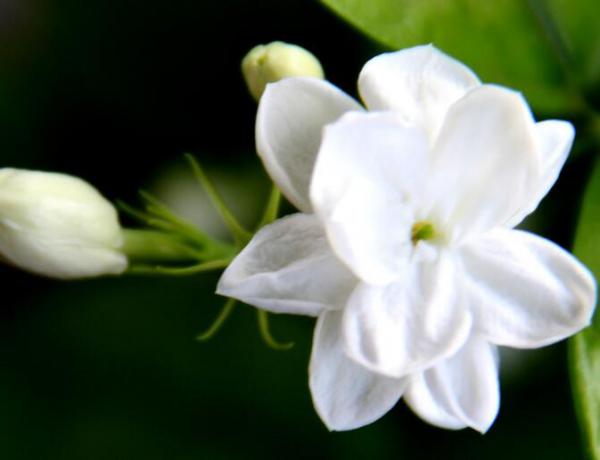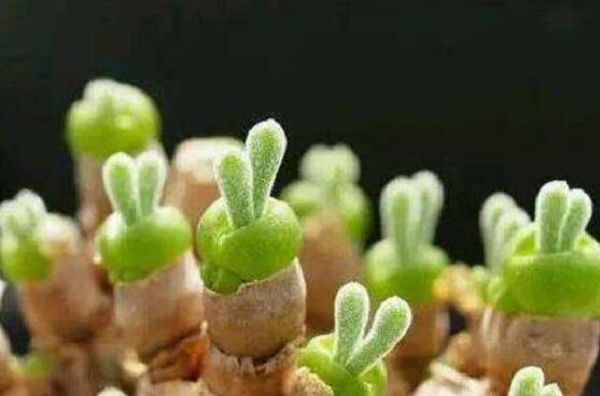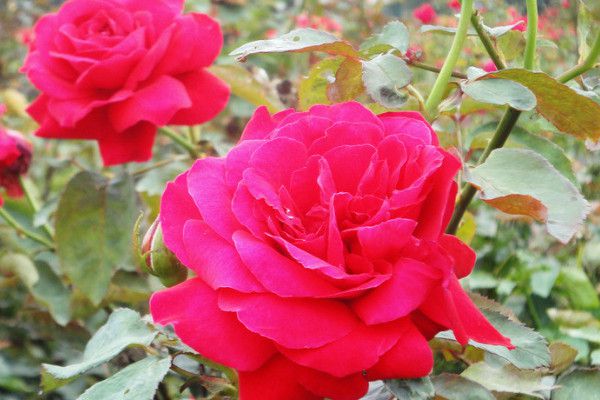How do you water jasmine flowers? The watering method of jasmine.

Water is the source of life, not only for human beings, but also for plants and animals, water is very important and a resource for survival. In the process of raising jasmine, often encounter the trouble of watering, how to water, how often, when can not be watered and so on, all need to pay attention to.
Although jasmine is tenacious and can be cultured successfully in general, incorrect use of water will bring damage to plants, such as wilting of water-deficient plants, shedding of leaves, wilting and so on. Excess water plant root yellowing, retting root, rot, wilting and other phenomena, in short, whether it is more or less water, to a certain extent, it will bring damage to the plant. So how to "drink water" to jasmine plants correctly?
How to judge whether jasmine should be watered or not
Jasmine plants like moisture, waterlogging and drought tolerance, so we should pay special attention to watering so as not to bring damage to the plants. If you want to see whether the plant needs watering, you can use the simple five-word formula of "seeing, listening, probing and touching" to judge. It refers to a look at the soil. The color of the soil is brown, which means it does not need watering, and the white color of the soil means it needs watering.
Second, looking at the plant, the emerald green growth of the plant leaves shows that the water is appropriate, the wilting of the plant shows that it is lack of water, and the yellowing and decay of the plant means that it is watered too much. Listen to the sound, knock down the outer basin with your hand, the sound is loud and clear that the soil inside is dry, and the sound is low and stuffy that there is enough water inside.
Exploration refers to the use of chopsticks and sticks into the soil, after 10 minutes, pull out to see whether the soil is dry or wet, dry and wet to determine whether it needs watering. Touching refers to touching the clods on the surface of the basin soil, if it is formed into a piece, it means that there is a lack of water, and if it feels a little soft, it means that the moisture is normal.
Moving refers to gently moving to feel the weight, usually to feel the weight of the normal growth of the plant, the basin is very light to show a lack of water, very heavy to move means that the amount of water is enough. You can choose one or two of these methods according to your own needs.
Second, according to the different water demand of jasmine flowers in four seasons, reasonable watering should be arranged.
The water demand of jasmine varies greatly in different seasons, and watering depends on the weather conditions throughout the year. Spring is the day when jasmine wakes up, sprouts and regains momentum, and its growth is slowly recovering. at this time, the demand for water is less. in addition, the temperature in spring is not very high and the water volatilizes slowly, so watering once can meet the demand for several days. so watering in spring should be less.
Suggestion: it only needs to be watered every 4-5 days in spring, and the watering time can be chosen when the temperature rises at noon. Do not water the root directly when watering. To prevent root injury caused by cold, you only need to use small water to water slowly along the edge of the basin to keep the soil moist.
Summer is the peak growth period of jasmine, and it also enters the flowering period, which requires a large amount of water or fertilizer. Coupled with the high temperature in summer, the moisture in the soil will soon become dry, and the upper part of the plant will be in a muggy environment for a long time. It also needs to be nourished by water, so summer watering should be watered frequently and thoroughly.
Suggestion: the demand for water in summer is the greatest, it needs to be watered thoroughly with large water, and water can be watered once or twice a day in the morning and evening, pay attention to avoid the high temperature at noon to prevent burns, and spray for 1-2 days can be added when the temperature is especially high, to increase humidity to the plant leaves and the surrounding air.
In autumn, when the jasmine flowers bloom to wither, the demand for water becomes less and less. In early autumn, when the flowers are still in bloom, the demand for water is still relatively large. When the flowers begin to fall from the branches in mid-late October, the water demand decreases gradually. At this time, reducing the moisture in the soil can also promote the jasmine roots to be stronger and more stable, so watering in autumn should be changed from more to less.
Suggestion: autumn this time period will be relatively special, the temperature from muggy to gradually cool, the increase of water from fast to slow, the need for water from early autumn to late autumn less, so watering should also be based on this characteristic, watering can be reduced from 1 to 2 days a day, reduced to 1 time, in the gradual reduction to 1: 2 days watering, and then transition to 3: 4 days watering, as long as the soil is moist.
In winter, the jasmine plant begins to enter the dormant period, and all aspects of the plant function basically stop running, and the demand for water is very little. in addition, the temperature in winter is relatively low and the weather is relatively cold, and the water in the soil volatilizes very little. so watering in winter should be lazy.
Suggestion: to reduce the amount of water and watering times in winter, you can water every 5-7 days, or for a longer time, it is better to irrigate with small water, choose the watering time at noon when there is plenty of sunshine, and keep the soil moist.
Third, if you want to grow good jasmine, you need to pay attention to these points.
1. Lighting
Jasmine is a light-loving plant, which has a great demand for sunlight. without light, the plants will grow too long, become thinner, yellowing, scorch at the edge of leaves and so on. So in the process of breeding, to let it bask in the sun, as long as it is not a violent strong light, that is, when the temperature in the air is not more than 38 ℃, it can be put outdoors.
Suggestion: if it is indoor farming, try to move out to bask in the sun every day. If the weather is cold in winter, you can move back indoors and move out when it is sunny. For newly transplanted seedlings or jasmine flowers in changing pots, do not directly expose them to the sun. To give it a mild process, you can first use astigmatism, slowly increase the area of exposure to sunlight, and finally follow normal light. If it is raised outdoors, the plant is relatively large and can not be moved. In the case of high temperature, the sunshade net can be built, and the low temperature can be set up to make a simple baffle to prevent the strong wind from blowing directly.
2. Pruning
Pruning is a necessary process for jasmine to grow well, the leaves are dark green and the flowers are fragrant. When the jasmine plant enters the peak growth period, the branches that continue to sprout will make the living space very crowded, the branches and leaves cross each other, and the ventilation and light transmittance become worse. If the interior of the plant is not pruned, it is difficult to get light, and in a shady environment, it is easy to let diseases and insect pests enter. At the same time, overgrown branches will waste the consumption of nutrients, make the plant slender and long, become very tall and not robust, reduce the disease resistance of the plant, and affect the flowering and fruiting of the plant, so pruning is very necessary.
Suggestion: cut off the outer branches when pruning, and sink in a little bit when cutting, that is to say, go in a little more than normal branches. At the same time, the dense branches of the inner chamber should be combed off to keep the inner part clean and bright. Pruning according to the principle of "long and dense, short and sparse or not", pruning can be done with new scissors or rusty scissors, scalded with boiling water or wiped with alcohol before use. After pruning all the branches and leaves, you can spray the whole plant with broad-spectrum germicidal disinfectant, which can not only play the role of sterilization and disinfection, but also promote wound healing.
To sum up: the watering of jasmine is very critical, too much or too little water will affect its growth, so it is necessary to water jasmine according to the characteristics of jasmine in the process of maintenance, that is, watering according to the different needs of water throughout the year. Less watering in spring, frequent watering in summer, reasonable watering in autumn and lazy watering in winter. Remember the "drinking water" principle of jasmine in these four seasons, you can make your jasmine grow full. At the same time, in order to make plants stronger and flowers bloom more, we need to do a good job of lighting and pruning.
Related
- Fuxing push coffee new agricultural production and marketing class: lack of small-scale processing plants
- Jujube rice field leisure farm deep ploughing Yilan for five years to create a space for organic food and play
- Nongyu Farm-A trial of organic papaya for brave women with advanced technology
- Four points for attention in the prevention and control of diseases and insect pests of edible fungi
- How to add nutrient solution to Edible Fungi
- Is there any good way to control edible fungus mites?
- Open Inoculation Technology of Edible Fungi
- Is there any clever way to use fertilizer for edible fungus in winter?
- What agents are used to kill the pathogens of edible fungi in the mushroom shed?
- Rapid drying of Edible Fungi



